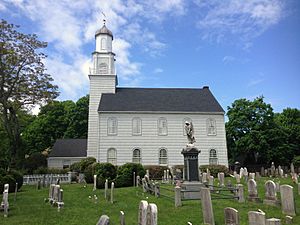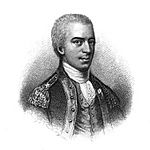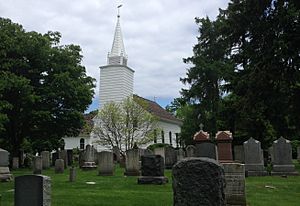Battle of Setauket facts for kids
Quick facts for kids Battle of Setauket |
|||||||
|---|---|---|---|---|---|---|---|
| Part of the American Revolutionary War | |||||||
 The current Setauket Presbyterian Church (built 1812), sits on the site of the Loyalist fortifications |
|||||||
|
|||||||
| Belligerents | |||||||
| Commanders and leaders | |||||||
| Samuel Holden Parsons | Richard Hewlett | ||||||
| Strength | |||||||
| 500 Continental Army infantry | 260 Loyalist militia | ||||||
| Casualties and losses | |||||||
| 1 wounded | none | ||||||
The Battle of Setauket happened on August 22, 1777. It was a fight during the American Revolutionary War. American soldiers tried to attack a fort held by British supporters in Setauket, Long Island, New York.
The American troops were from Connecticut. They were led by Brigadier General Samuel Holden Parsons. Parsons wanted to repeat a past success, the Meigs Raid. In that raid, American forces had surprised and captured supplies from British supporters.
Parsons' soldiers crossed Long Island Sound to reach Setauket. But spies had already warned the British supporters. Their leader, Lieutenant Colonel Richard Hewlett, made the local church into a strong fort. He built a fence and dirt walls around it.
Parsons asked Hewlett to give up, but Hewlett said no. A short battle then took place. It didn't cause much damage. Parsons decided to leave and went back to Connecticut. The British supporters won this battle.
Contents
Why the Battle Happened
In 1776, the British had some wins in the American Revolutionary War. They had to leave Boston but then captured New York City. However, General George Washington surprised them at Trenton and Princeton. This meant the British could not hold New Jersey.
The British kept control of New York City and Long Island. The American army, called the Continental Army, surrounded the city. They set up a blockade in New Jersey, southern New York, and southwestern Connecticut.
In the spring of 1777, British General William Howe sent out raiding parties. These groups attacked American army supply places near New York City. One raid in March against Peekskill, New York was successful. This made General Howe plan a bigger raid on a supply depot in Danbury, Connecticut.
This bigger raid was led by William Tryon. He was the former royal governor of New York. His troops landed in Westport, Connecticut and reached Danbury on April 26. They destroyed many supplies. The Connecticut militia, a local army, fought back. They had small battles with the British as they marched back to their ships. A notable fight was at Ridgefield.
General Samuel Holden Parsons was in charge of Connecticut's defenses. He decided to plan a revenge attack.
Planning the Attack
A successful raid by Colonel Return Jonathan Meigs against Sag Harbor on eastern Long Island gave Parsons an idea. He thought about more attacks on other places held by British supporters, called Loyalists, on Long Island.
On August 16, Parsons received orders from Major General Israel Putnam. These orders allowed him to plan an attack on Loyalist targets on Long Island. Parsons quickly told Colonel Samuel Blachley Webb to gather his soldiers. Webb's group, called his regiment, had about 500 men. They marched to Fairfield, Connecticut. Parsons followed and arrived in Fairfield on August 21.
Loyalists from Queens County, New York had formed a group. They were led by Lieutenant Colonel Richard Hewlett. In early August, they set up a fort in Setauket. This town was on the north shore of Long Island, right across Long Island Sound from Fairfield.
Hewlett's soldiers took over the town's Presbyterian meeting house. They made it stronger. When spies told Hewlett that Parsons was getting his troops ready in Fairfield, Hewlett improved his defenses. He built a strong wall, called a breastwork, six feet (about 2 meters) high. This wall was about 30 feet (9 meters) away from the meeting house. On these walls, he placed four small swivel guns. These were small cannons that could turn easily.
The Battle Itself
On the night of August 21, Parsons and Webb crossed Long Island Sound. They used whaleboats and brought a few small brass cannons. Early the next morning, they landed at Crane's Neck. This area is now called Old Field, just west of Setauket. From there, they marched to Setauket.
Parsons saw that the Loyalists were very well protected. First, he sent a message asking them to surrender. Hewlett refused. Then, the two sides started shooting at each other. The fight lasted for about three hours.
Neither side had many injuries. Colonel Webb reported that only one American soldier was wounded. The small American cannons could not break through the strong walls of the fort. Parsons also worried that British ships in the Sound might hear the battle. He thought they would come to investigate. So, Parsons decided to stop the attack and retreat. He took about a dozen captured horses and some blankets with him.
What Happened Next
The American attackers successfully crossed back over the Sound. Parsons then told Webb's soldiers to patrol the Connecticut shore. In December 1777, Parsons, Webb, and Meigs tried another, more complex attack on British military supplies at Setauket.
This second attempt failed. Rough seas stopped Meigs from crossing. Also, a British ship captured Webb's boat.
Lieutenant Colonel Hewlett was praised for defending his post. However, the fort was left empty a few months later. Setauket was not attacked by a large group again. But it was often the target of smaller raids.
Setauket was also an important place for secret information. American spies in New York sent messages through Setauket to Washington's spy chief, Benjamin Tallmadge. Tallmadge was from Setauket. He ran a spy network called the Culper Ring. Many people from Setauket were important members of this spy group.
A Patriot, Zachariah Greene, had to leave Long Island. He was part of Parsons' expedition. Later, he became a minister for the Setauket Presbyterian church. A new church building was built on the same spot in 1812.
The Battle in Pop Culture
The Battle of Setauket is shown in a TV show called Turn: Washington's Spies. It appears in the last episode of season one. In the show, Major Benjamin Tallmadge leads the American forces. They fight against the British soldiers led by a character named Major Edmund Hewlett.




